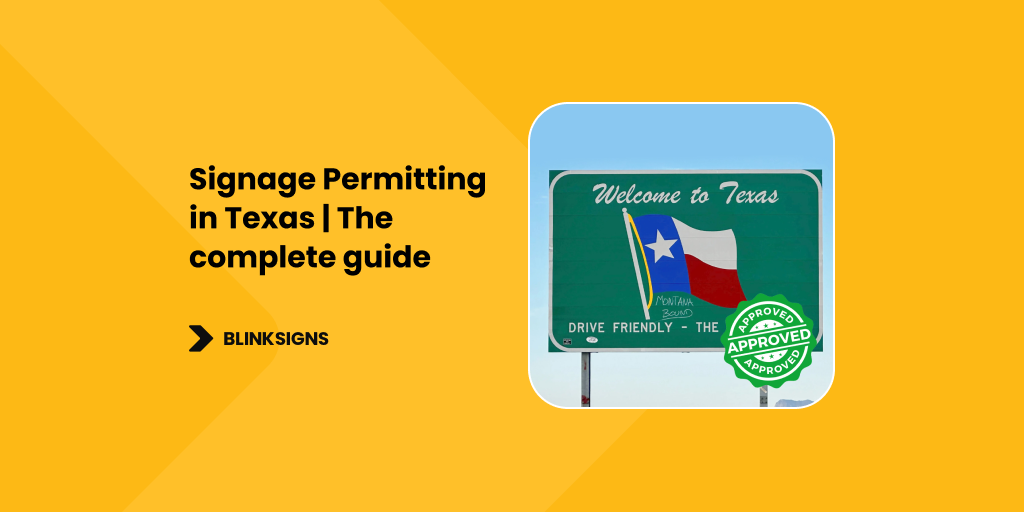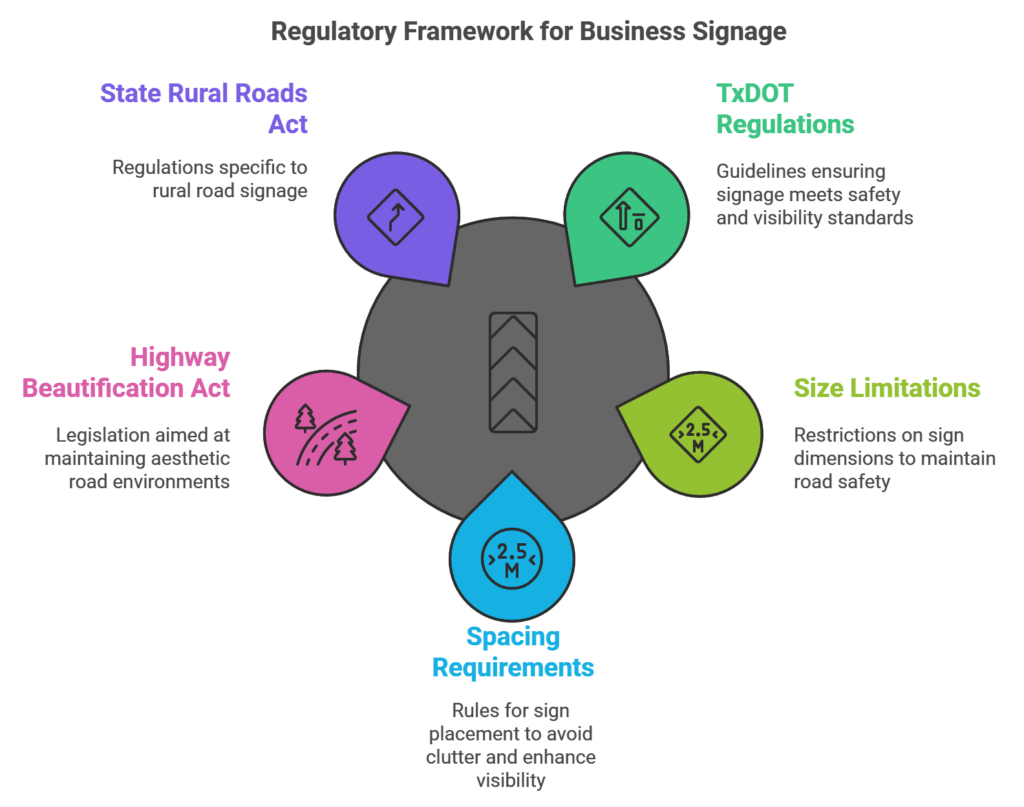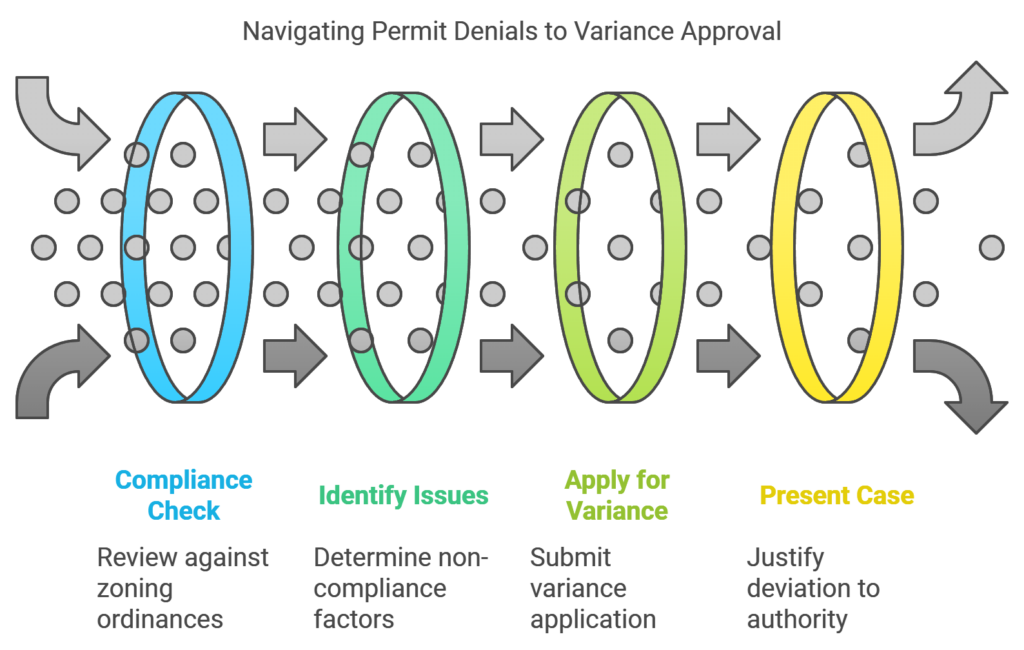
Signage Permitting in Texas: Avoid Fines, Stay Compliant
Signage is an indispensable tool for Texas businesses, serving as a brand marker and a critical component of customer engagement. Each sign tells a unique story, from the tech startups in Austin’s Silicon Hills to the vibrant tourism-driven shops of San Antonio’s River Walk. However, erecting a sign in Texas means navigating complex legal landscapes that involve regulations from the Texas Department of Transportation (TxDOT), municipal codes, and zoning ordinances at county levels.
The goal? Ensuring each sign meets state and local compliance standards, preserving public safety and community aesthetics.
At BlinkSigns, every business faces distinct signage challenges, whether in a bustling city like Dallas or a quieter area like Fredericksburg. This guide outlines essential details for signage permitting in Texas, helping businesses secure permits and confidently maintain compliance. By aligning with state standards like the Highway Beautification Act (HBA) and State Rural Roads Act (RRA), BlinkSigns assists businesses in creating impactful signage that resonates within each Texas community.
Understanding Texas Signage Permit Types
Texas classifies signage into various categories, each tailored to specific uses and with unique regulatory requirements. On-premise signs—typically placed directly on business properties like storefronts, restaurants, or office complexes—are permitted under local zoning rules and subject to size, height, and illumination standards. In contrast, off-premise signs, including billboards along major highways, face stricter regulations, especially near highways governed by TxDOT. These signs require thorough compliance with setback requirements, as they must maintain an appropriate distance from roadways to prevent obstruction and distraction.
Digital signage, such as Electronic Message Centers (EMCs) and illuminated LED signs, are increasingly popular across commercial areas in Texas cities like Houston and Austin. However, brightness, frequency of message changes, and animation limits are enforced to ensure these signs do not distract drivers. Temporary signs—such as promotional banners or event signage—are commonly seen in suburban areas but come with strict duration limits and specific placement guidelines to prevent excessive visual clutter.
At BlinkSigns, we assess each sign type’s requirements, guiding clients through the necessary approvals while creating effective signage that adheres to Texas’s compliance framework.
Key Texas State Regulations for Signage Compliance
State-level regulations set by TxDOT are critical for any business signage visible from Texas highways and state roads. Key aspects of these regulations, including size limitations and spacing requirements, ensure that signage enhances visibility without compromising safety. The Highway Beautification Act (HBA) and State Rural Roads Act (RRA) mandate specific controls on sign dimensions and positioning, particularly for off-premise signs like billboards.

Regulatory Framework for Business Signage in Taxes
TxDOT also enforces rules on illumination, especially for digital signs that could distract drivers. For instance, cities like Austin impose brightness and animation restrictions on Electronic Message Centers (EMCs) along significant roadways to align with TxDOT’s road safety protocols. Compliance with these guidelines is essential for businesses that maintain a safe and visually appealing presence near highways.
BlinkSigns provides expertise in adhering to TxDOT standards, helping clients achieve state-mandated compliance without compromising visibility or brand messaging.
Local Zoning Codes and Permit Requirements Across Major Texas Cities
Each major Texas city has unique permitting regulations based on local zoning laws, creating an intricate tapestry of signage standards that can vary considerably. In Austin, signage within designated zones like the Downtown Sign District permits higher density and visibility, while historic areas enforce stricter visual limitations to preserve aesthetic integrity. Similarly, Houston uses zoning regulations to dictate permissible sign heights and sizes in commercial, residential, and mixed-use areas.
In San Antonio, businesses in historical districts like Alamo Plaza require additional approval to ensure signs match the historic surroundings. Meanwhile, Dallas is known for enforcing rigorous sign height and setback restrictions to protect neighborhood views, especially in residential zones.
BlinkSigns ensures each sign we manage meets the nuanced requirements of Texas’s cities, allowing businesses to remain compliant and relevant to the communities they serve.
Step-by-Step Guide to Signage Permitting in Texas Process
The permitting process in Texas follows a series of steps, each crucial to ensuring signage compliance and approval.
Application Preparation
- Research local zoning codes to understand specific size, location, and type requirements. Gather necessary documentation, including site plans, elevation drawings, and construction details to meet submission criteria.
Submission and Review
- Submit the completed application to the appropriate municipal permitting office or TxDOT, where officials evaluate it against setback requirements, illumination standards, and structural codes.
Inspection and Approval
- Inspections may be necessary to confirm electrical compliance and structural integrity for illuminated or structurally complex signs.
Permit Issuance
- Once approved, a permit is issued, allowing the business to install signage in compliance with Texas regulations. BlinkSigns guides clients through each step, providing a seamless permitting experience.
Here’s an updated detailed table that covers specific signage permitting standards and requirements across Texas’s major cities, focusing on unique regulations to guide businesses more accurately:
| City | Permitting Authority | Permit Requirements | Special Considerations |
| Austin | Development Services Department | Permits are required for all signage types; size and height vary by zone | Historic districts (e.g., South Congress) have strict aesthetic controls. EMC brightness and placement limits apply. |
| Houston | Planning and Development Department | Comprehensive permit for illuminated, large, and digital signs; specific setback rules for residential proximity | Illuminated signs face size and brightness restrictions near neighborhoods; commercial zones allow higher signage. |
| Dallas | Building Inspections Department | Size, height, and setback standards for all signs; EMCs require separate permits | Historic districts require additional review; and restrictions on EMCs in residential and mixed-use zones to control brightness. |
| San Antonio | Development Services Department | Strict limits on size and height, with permits required for all signs | Alamo Plaza and other historic areas impose stringent material and design guidelines for signage compliance. |
| Fort Worth | Planning and Development Department | Permits for all signs based on size and location; inspection fees apply for EMCs | Additional permit review for signage along major highways. Historic areas require design adherence. |
| El Paso | Code Enforcement | Permits and precise setback requirements, including height and spacing for large signs | Scenic Drive and environmentally sensitive zones restrict illuminated signage. EMCs face size and brightness limits. |
| Corpus Christi | Development Services Department | Size and placement permits; setbacks for all signage along water-adjacent areas | Signs near waterfront zones must comply with additional visibility and environmental impact guidelines. |
| Lubbock | Code Administration | Standard permit requirements for all signage, including EMCs and digital billboards | Special height and setback standards for areas near schools. Illumination controls near residential zones. |
| Amarillo | Building Safety Department | Setbacks and spacing for signage along major roads; EMC permits required for illuminated signs | Illumination restrictions in residential-adjacent areas; additional permit review for tall signage. |
| Plano | Planning Department | Compliance with height, size, and setback for all signs; detailed review for EMCs | Temporary signage is restricted by duration and size in commercial areas. Digital displays must comply with brightness limits. |
Avoiding Common Pitfalls: Signage Permit Denials and Variances
Permit denials often stem from non-compliance with zoning ordinances or exceeding size, height, or illumination limits. For businesses needing special accommodations, a variance may be required to deviate from established regulations. A variance application involves submission to the Board of Adjustment or similar local authority, where a case is presented to justify the deviation.

Permit Denials to Variance Approval
Variance requests can involve extensive documentation and justification, particularly in areas with strict standards like historic districts. With BlinkSigns, businesses have a partner to navigate these complexities, preparing applications and developing solid cases for variance approvals where necessary. This proactive approach reduces delays and helps clients avoid common setbacks in Texas’s regulatory landscape.
Fees, Costs, and Investments for Texas Signage Permits
Texas signage permits involve various fees, often influenced by sign type, location, and specific city standards. For example, permits in downtown Houston or Austin may carry higher fees due to commercial zoning. Additional costs include inspection fees, bond requirements, and insurance for high-traffic zones. In areas like Dallas, illuminated signs may require separate electrical permits, adding further costs.
Budget planning is essential for successful signage, and BlinkSigns offers detailed cost breakdowns, including initial permit fees, inspections, and maintenance costs, ensuring clients understand the financial commitments involved. With our guidance, businesses can plan their budgets accurately and invest in signage aligning with brand goals and regulatory standards.
Ensuring Environmental and Aesthetic Compliance
Environmental and aesthetic considerations are key to Texas’s signage regulations, particularly in cities prioritizing sustainability. For illuminated signage, regulations on brightness and light pollution help mitigate environmental impact. LED lighting is encouraged for energy efficiency, while some municipalities, such as Austin, incentivize using recyclable materials and eco-friendly components.
In residential or mixed-use zones, illumination restrictions and color schemes are enforced to align with the surrounding environment. BlinkSigns supports businesses in developing sustainable signage options that meet environmental standards and showcase the business’s commitment to eco-conscious practices.
Tips for Maintaining Texas Sign Permits and Renewals
Permitting compliance in Texas doesn’t end with issuance. Businesses must maintain their signage according to Texas’s building codes, ensuring ongoing structural and electrical safety. Regular maintenance, such as inspections for wear and timely renewals, is essential, especially for temporary or illuminated signs.
Sign permits for temporary signage in high-traffic areas like San Antonio’s Market Square often come with shorter validity periods and require renewal. BlinkSigns helps businesses manage renewals efficiently, maintaining compliance and avoiding penalties or forced sign removal.
Penalties and Consequences for Non-Compliance in Texas
Non-compliance with Texas signage regulations can result in significant penalties. Fines for unpermitted signage or oversized signs are common in cities like Austin and Houston, with additional enforcement measures that may require businesses to modify or remove non-compliant signs. Repeated violations can lead to negative publicity, potentially affecting a business’s community reputation.
At BlinkSigns, we prioritize compliance to protect businesses from fines, removal orders, or other legal actions. By keeping clients informed of regulatory changes, we help them avoid non-compliance pitfalls, securing their investments in signage.
FAQs
What are the requirements for ADA signage in Texas?
ADA signage in Texas must include Braille or raised Text, comply with specific placement heights, and ensure easy readability. All public buildings and facilities must meet these ADA standards to support accessibility. BlinkSigns can guide you through ADA compliance for your signage needs.
How much is a sign permit in Houston?
Sign permit fees in Houston vary by sign type, size, and location, generally ranging from $100 to several hundred dollars for complex signs or those with illumination. Contact BlinkSigns for an accurate estimate based on your unique project.
Who regulates billboards in Texas?
The Texas Department of Transportation (TxDOT) regulates billboards in Texas, particularly along highways and rural roads. TxDOT enforces size, spacing, and location restrictions to ensure public safety and compliance with state regulations.
Do you need a sign permit in Harris County?
Yes, most signs in Harris County require a permit, especially those visible from highways or over a specific size. Harris County enforces local signage codes to ensure safety and aesthetic consistency.
What are the ADA rules for signage in Texas?
ADA signage in Texas requires Braille, raised characters, non-glare finishes, and specified installation heights for accessibility. BlinkSigns ensures your signage meets these ADA standards, enhancing customer accessibility.
Are billboards taxable in Texas?
Yes, billboards in Texas are subject to property taxes, as they are classified as real property improvements. Tax rates may vary by county, affecting billboard owners and advertisers nationwide.
How long does it take to get a sign permit in Texas?
Permitting timelines vary by city and sign type but generally range from 1 to 4 weeks. Expedited processing may be available for some projects. BlinkSigns can help streamline the process of securing permits efficiently.
Are digital signs allowed on Texas highways?
Yes, but digital signs along Texas highways must comply with TxDOT’s brightness, animation, and placement standards to avoid distractions for drivers. BlinkSigns can ensure your digital signage aligns with these rules.
What are the height restrictions for signage in Austin?
Austin imposes height limits based on zoning, with commercial zones allowing taller signage compared to residential areas. Specific limits apply within historic districts as well. Consult BlinkSigns for guidance on meeting Austin’s height requirements.
Do historic districts in Texas have unique signage requirements?
Yes, historic districts like those in San Antonio’s Alamo Plaza enforce stringent design, materials, and placement guidelines to preserve the area’s character. BlinkSigns offers expertise in compliant signage solutions for Texas’s historic zones.
Conclusion
BlinkSigns combines regulatory expertise with creative solutions, helping Texas businesses navigate complex permitting landscapes. From initial design consultation to full permit issuance, we collaborate with TxDOT, local planning departments, and historic preservation boards to ensure every sign meets the necessary standards. Let BlinkSigns be your guide to impactful, compliant signage across Texas’s cities and towns. Contact us today at Sales@blinksigns.com or +1 877-433-4466 for more details.